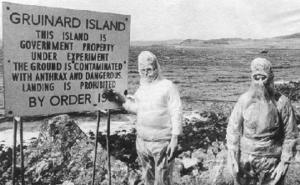Budget cuts more than $600 million from Bioshield program
Randall Larsen, executive director of the congressionally chartered Commission on the Prevention of Weapons of Mass Destruction Proliferation and Terrorism: “Using Bioshield funds for flu preparedness and other issues not associated with national security will severely diminish the nation’s efforts to prepare for WMD events and will leave the nation less, not more, prepared”

U.K.'s 1940s biowarfare test site // Source: cs-faculty.stanford
A spending plan approved last month by President Barack Obama transfers more than half a billion dollars from the coffers of a leading effort intended to promote development of countermeasures against weapons of mass destruction. Roughly $609 million was shifted in this fiscal year from the Project Bioshield Special Reserve Fund, according to the Consolidated Appropriations Act.
Lawmakers moved $304 million to the Health and Human Services Department’s National Institute of Allergy and Infectious Diseases and approved a White House request to transmit $305 million to an account within that department’s Biomedical Advanced Research and Development Authority. Globalsecuritynewswire’s Martin Matishak writes that the transfer opens the door for the funds possibly to be used in sectors not solely devoted to threats posed by terrorism or rogue nations.
The Bioshield fund will now have roughly $2.4 billion available through fiscal 2013 to “procure and stockpile emergency countermeasures,” the legislation states.
The measure also granted an administration proposal to transfer the fund’s remaining balance from the Homeland Security Department to Health and Human Services, giving the agency full responsibility for managing the account.
Created in 2004, Project Bioshield was intended to receive about $5.6 billion over 10 years to purchase medicines designed to protect U.S. citizens from the effects of a WMD attack. The program ostensibly provided biotechnology and pharmaceutical companies with assurances that the federal government would purchase successful countermeasures against bioterrorism and other WMD agents, bolstering the medical countermeasure industry.
Matishak writes that tThe program has had its share of troubles. Its largest project, an $877.5 million program for production of a new anthrax vaccine, was canceled in 2006. This was followed in 2007 by the suspension of an effort to produce a drug for radiation exposure.
The program to date has purchased about $2 billion worth of countermeasures for the U.S. Strategic National Stockpile. That program works to store medical countermeasures and other supplies in the event of a bioterrorism attack or other health emergency.
Congress also has decreased the amount available in the Bioshield account. In fiscal 2004 and 2005 lawmakers removed a total of $25 million and in 2009 they transferred $412 million to other programs to support “countermeasure advanced research and development and pandemic influenza preparedness and response,” according to a Congressional Research Service (CRS) report on Project Bioshield.
House lawmakers, in their version of the fiscal 2010 spending legislation, suggested transferring $500 million to the infectious diseases institute, saying the Bioshield program has
